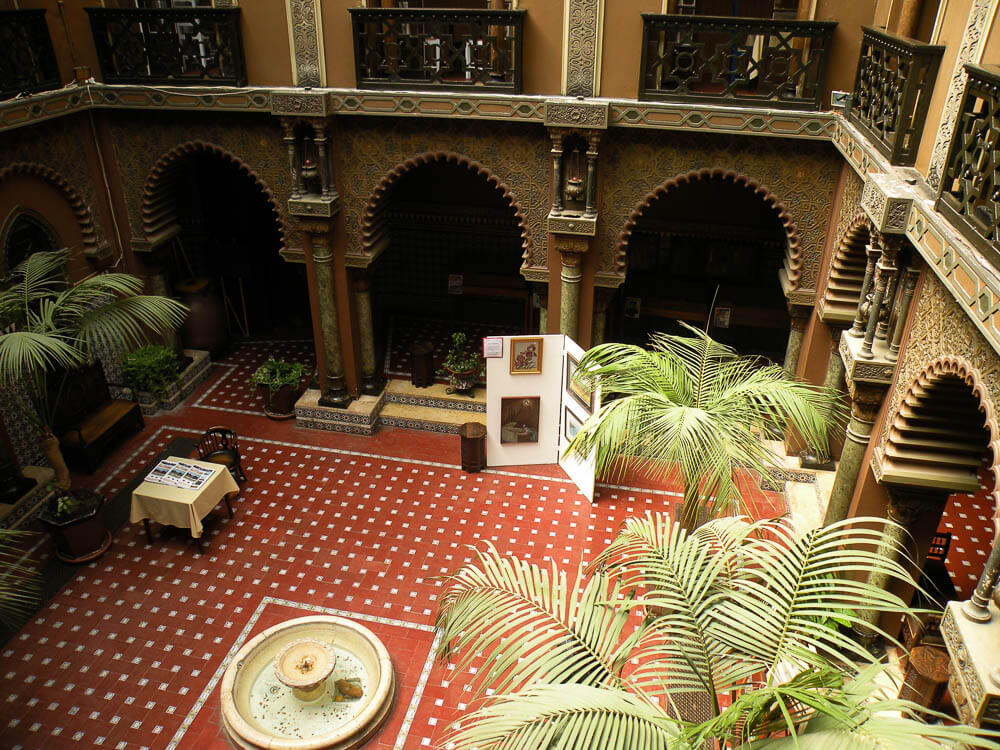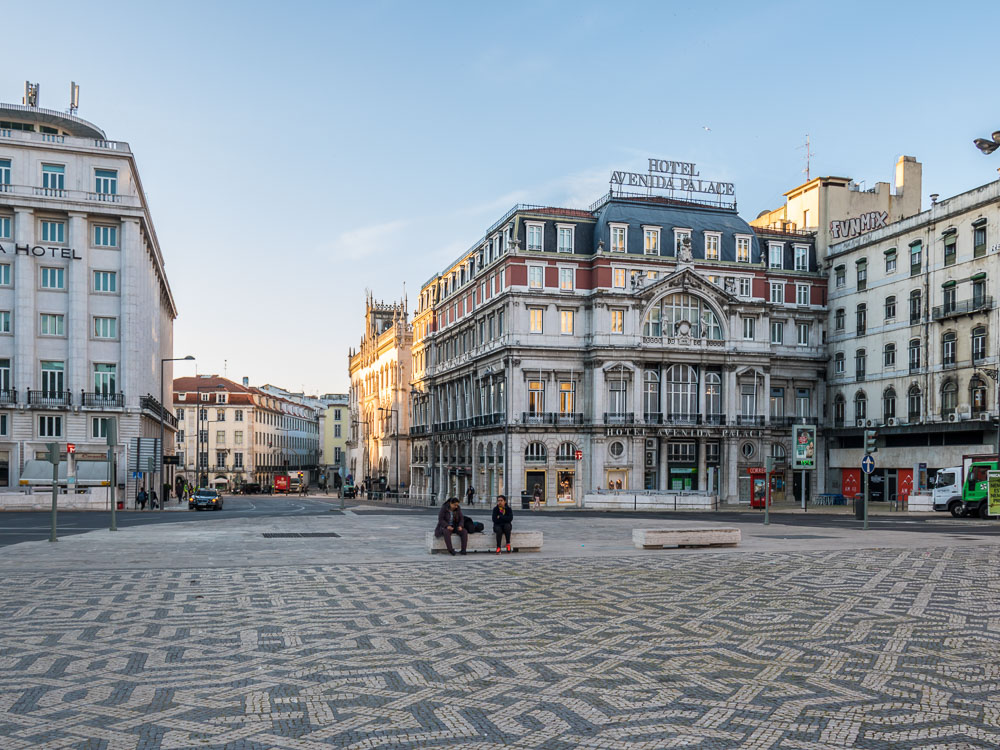Avenida da Liberdade is the largest and most famous avenue in Lisbon, known for its high-end stores, hotels and restaurants. But you should know that this isn’t just a commercial area. It’s also filled with culture and history, blending Lisbon’s roots with modernity.
Whether you’re interested in luxury shopping or historical buildings, Avenida da Liberdade will definitely have something for you. So, join me as I tell you everything you need to know before visiting this avenue!
Index
- Highlights of Avenida da Liberdade
- What to see and do in Avenida da Liberdade?
- Where to stay in Avenida da Liberdade?
- History

1. Highlights of Avenida da Liberdade
Whether you’re looking forward to indulging in some luxury shopping, admiring the unique blend of modernity and history, or tasting really amazing Portuguese dishes, I can assure you that Avenida da Liberdade won’t let you down! Here are the highlights of visiting this avenue:
1.1. Designer shops
If you like designer shops then you’ll love Avenida da Liberdade! This is one of the main shopping streets in Lisbon, and you’ll find many international fashion brands there, including Prada, Burberry, Cartier, Miu Miu, Louis Vuitton, and Gucci.
But that’s not all. The range of shops in this boulevard has grown a lot in the last few years, with specialty boutiques sitting next to well-known labels to provide an alternative to the luxury items.
And, if you’re not interested in buying very expensive clothes, don’t worry! Doing some window shopping can be just as fun. Personally, I recommend taking your time as you walk down the avenue, checking out all the latest fashion trends displayed in store windows without spending any money.
1.2. Architecture
Avenida da Liberdade is a place that effortlessly blends historical and modern architectural styles. While some modern developments have replaced some older buildings, you can still find historic structures from the 18th and 19th centuries.
Some of the original mansions along the avenue showcase neoclassical architecture, characterized by symmetrical facades, columns, and ornate detailing, while others have Art Nouveau elements, with its intricate decorative elements, sinuous lines, and organic motifs.
As the avenue evolved into a commercial and business center, it began to feature more modern designs, with glass façades, sleek lines, and other contemporary elements that reflect the urban renewal and modernization of the area.
Avenida da Liberdade is also known for its mosaic pavements called “calçadas portuguesas.” These black and white pathways not only serve a practical purpose but they’re also a big part of Lisbon’s visual identity!
1.3. Culinary scene
Another highlight of Avenida da Liberdade is its diverse culinary scene, with restaurants serving both contemporary and traditional Portuguese food. There really is something for everyone!
Some of the most sought-after locations include the Hard Rock Café, recognized for its combination of American food and rock-themed decor and Cervejaria Ribadouro, which serves great seafood.
There’s also As Velhas, offering typical Portuguese dishes, and the JNcQUOI, which is noted not only for retail but also for its restaurant which presents a mix of modern style and Portuguese culinary traditions. If you prefer, you can also explore the side streets, which offer even more food options!
2. What to see and do in Avenida da Liberdade?
2.1. Parque Eduardo VII

Parque Eduardo VII, named after England’s King Edward VII who visited the city in 1903, is the largest park in Lisbon, located at the northern end of Avenida da Liberdade. It’s a very popular place among both locals and tourists, as it offers a green space away from the city noise, with walkways and gardens with views over Lisbon.
There, you’ll be able to explore the Estufa Fria, a greenhouse that consists of three parts: Cold Greenhouse, Hot Greenhouse and Sweet Greenhouse, each with a great variety of specimens from all over the world, from orchids to cacti.
You can also visit the Carlos Lopes Pavilion, a beautiful tiled building used for public and private events, which also holds an exhibition in honor of the Portuguese athlete Carlos Lopes. It’s really worth visiting, even if just to look at the tile panels on the façade!
2.2. Ascensor do Lavra

The Ascensor do Lavra is Lisbon’s oldest funicular, operating since 1884. Although it has great historical importance, it doesn’t reach major attractions, which makes it less popular than other trams in the city, like Tram 28.
Starting at Largo da Anunciada and ending at Rua Câmara Pestana, it offers a three-minute ride every 10 or 15 minutes, and provides access to the tranquil Torel garden, where you can relax and enjoy views of central Lisbon.
Since it’s conveniently located near Avenida da Liberdade, the Ascensor do Lavra provides an opportunity for exploring lesser-known city areas without having to travel far or deal with too many tourists.
2.3. Rossio Train Station

Rossio Train Station, designed by José Luís Monteiro, serves both as a transport hub and a cultural landmark. It’s a great example of late 19th-century Portuguese architecture, with its Neo-Manueline style that reflects Portugal’s maritime history.
While not as busy as Oriente Station, Rossio stands out in Lisbon’s skyline due to its stone arches and clock tower, and it’s known for its unique façade and high ceiling with intricate details.
With its central location near Avenida da Liberdade, Rossio Train Station is convenient for both local residents and tourists, and serves as the main departure spot for trains to Sintra, known for its palaces and gardens. It’s an ideal starting point for exploring the city or going on day trips!
2.4. Praça dos Restauradores

Praça dos Restauradores is a square built to celebrate the country’s independence from Spanish rule in 1640. It features an obelisk inscribed with significant dates and figures from that period of Portuguese history, and includes the 18th-century Foz Palace that now hosts a tourist information office.
Nearby is Elevador da Glória, a traditional funicular that connects downtown Lisbon to the Bairro Alto neighborhood, known for its nightlife and cultural scene. This funicular isn’t only a practical option to navigate the city’s steep streets, but it’s also a big part of Lisbon’s history.
2.5. Casa do Alentejo

Casa do Alentejo is a gathering space for people from the Alentejo region. Located a short distance from Avenida da Liberdade in Lisbon, it’s housed in a 17th century building that was once a palace.
The interior showcases various styles, including Moorish Revival and rococo details, and the walls feature historical tiles from the 19th and 20th centuries depicting Portugal’s artistry. One of the highlights is the Louis XVI-style ballroom on the upper floor that is used for events.
The Casa do Alentejo also includes a restaurant that offers traditional dishes from Portuguese cuisine, particularly those typical of the Alentejo area.
2.6. Cinema São Jorge and Cinemateca

Cinema São Jorge opened in 1950 on Avenida da Liberdade, premiering “The Red Shoes”. It became well-known in Lisbon’s film scene, but faced challenges with the rise of modern multiplexes. Despite this, it regained popularity as a venue for film festivals like IndieLisboa and QueerLisboa.
A short walk away is the Cinemateca Portuguesa, Lisbon’s Museum of Cinema, which offers exhibits related to film history, and classic movie screenings that allow visitors to see older movies in their original format.
It also houses collections that include 19th-century film equipment, and a research library and photo archive that is open to visitors. Both venues are a must-visit for any movie buff!
2.7. National Sports Museum

Since 2012, the National Sports Museum has been located in Foz Palace at Praça dos Restauradores. Its mission is to preserve and showcase Portugal’s sports history through various artifacts and memorabilia.
The museum houses a substantial sports library with more than 60,000 volumes, serving as a resource for researchers and those interested in sports literature. Included in the collection is “De Arte Gymnastica,” a 16th-century work that is considered the first book on sports.
It also hosts temporary exhibitions with items from renowned Portuguese athletes, such as Rosa Mota’s equipment, Nelson Évora’s sneaker from his victory at the 2008 Olympics, Eusébio’s Golden Shoe award, and Cristiano Ronaldo’s cleats. If you’re a sports fan, I’m sure you’ll love this museum!
3. Where to stay in Avenida da Liberdade?
Avenida da Liberdade is a very convenient place to stay, as it’s very central and close to lots of Lisbon’s attractions. Here are my main hotel recommendations in this area:
- Blue Liberdade: this 3-star hotel, located near Avenida da Liberdade, provides amenities such as free WiFi, buffet breakfast, and a 24-hour front desk. The concierge service assists with airport transfers and car rentals, and some rooms feature city views from balconies. Nearby attractions like Rossio Square, Dona Maria II National Theatre, and Commerce Square are within walking distance.
- Hotel Lisboa Plaza: this family-run 4-star hotel is also conveniently situated near Liberty Avenue. It showcases Portuguese style in its accommodations, and offers free WiFi, flat-screen TVs, and city views from the terrace. Guests can enjoy the library, fitness center, and daily breakfast. Its proximity to Avenida Metro Station makes exploring Marquês de Pombal Square and Glória Funicular easy.
- Portobay Liberdade: this 5-star hotel blends historical architecture with modern amenities, including minibars, flat-screen TVs, and toiletries in each room. Services like daily breakfast, bar access, and private parking are provided, with round-the-clock front desk assistance and room service available. Its location near Marquês de Pombal Metro Station makes it very convenient for exploring Lisbon.
4. History
The Avenida da Liberdade originated from the 1764 boulevard called Passeio Público, built after the 1755 earthquake as part of Lisbon’s reconstruction led by the Marquis de Pombal. The area was initially surrounded by a high wall, until D. João VI decided to tear them down in 1821.
The avenue as we know today was built between 1879 and 1886, inspired by the boulevards of Paris. It stretches for 3,600 ft from Restauradores Square to Marquês de Pombal Square, and is 300 ft wide, making it one of the city’s broadest roads.
Lined with both well-preserved mansions and modern buildings, Avenida da Liberdade is home to landmarks such as the Monument to the Heroes of the Great War, and is close to many major attractions.
Today, Avenida da Liberdade is known for its high-end hotels and shops, such as the well-known luxury brands Louis Vuitton, Prada, and Burberry. It’s a place that blends past elegance with contemporary shopping experiences, making for a fascinating experience that you just can’t miss during your time in Lisbon.
Ready to explore Lisbon’s most famous avenue?

Avenida da Liberdade isn’t just a commercial street filled with luxury brands: it’s an important part of Lisbon’s past and present.
Surrounded by both historical and modern buildings, this avenue is a place that brings together locals and tourists, providing a glimpse into the Portuguese lifestyle. That’s why it’s such an important part of any visit to Lisbon.
So, make sure to visit Avenida da Liberdade at least once, and take your time to appreciate its tree-lined promenade, monuments and buildings. I’m sure you won’t regret it!







